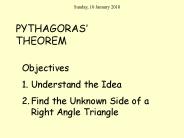The Theorem of Pythagoras - PowerPoint PPT Presentation
1 / 9
Title:
The Theorem of Pythagoras
Description:
The Theorem of Pythagoras Pythagoras The Theorem of Pythagoras Pythagoras The aim of this lesson is to be able to use Pythagoras Theorem to find the length of one ... – PowerPoint PPT presentation
Number of Views:250
Avg rating:3.0/5.0
Title: The Theorem of Pythagoras
1
The Theorem of Pythagoras
- Pythagoras
2
The aim of this lesson is to be able to use
Pythagoras Theorem to find the length of one of
the sides in a right-angled triangle given the
other two sides.
Also to be able to solve more difficult problems
involving right-angled triangles.
3
Pythagoras Theorem says that
c2 a2 b2
4
Find x
Longest side (hypotenuse) x
So x2 152 222
225 484
To find x we square root 709
709
Therefore x ?709
2663
5
Now well see what happens when we need to look
for a shorter side
Find x
Longest side (hypotenuse) 27
272 x2 112
272 - 112 x2
x2 272 - 112
Note these are the same 272 - 112 x2 and x2
272 - 112 Just flipped around
729 - 121
608
Therefore x ?608
2466
6
Now well look at two worded problems which
involve the use of Pythagoras
7
This house extension has a roof as shown.
Calculate the width of the extension.
- extract the right-angled triangle
- write in the lengths of each side
4
12
( 42 3)
w
42 w2 122
Pythagoras Theorem c2 a2 b2
Which means that w2 42 - 122
16 - 144
1456
Therefore x ?1456
382
8
A flagpole is supported by 2 ropes as shown in
the diagram. Find the height of the flagpole.
- extract the right-angled triangle
- write in the lengths of each side
25 m
h
half of 14 m flagpole is a line of symmetry in
an isosceles triangle.
7 m
252 h2 72
Which means that h2 252 - 72
625 - 49
576
Therefore h ?576
The flagpole 24 1 25 m
24
9
(No Transcript)































